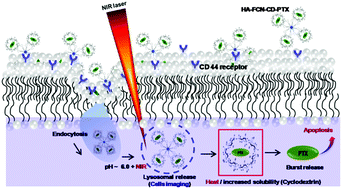The development of cooperative drug delivery systems that can detect and target the disease site, with rapid trigger controlled drug release (internally and externally), is widely expected to change the landscape of future drug carriers. In this study a drug delivery system was developed for the cancer-targeted release of chemotherapeutic agents inside living cells. This system is an environment sensitive (pH), and external photothermally remote controlled, cooperative image-guided drug delivery matrix. Partially carbonized fluorescence hyaluronic acid (HA-FCN) was conjugated with boronic acid (BA) to promote the formation of boronate ester with diol groups of β-cyclodextrin (CD) [HA-FCN–CD]. The pH influence mediated release of paclitaxel (PTX) from the CD cavity of HA-FCN–CD was utilized for targeted cancer bioimaging. This active-target delivery system (HA-FCN–CD–PTX) was found to show optical absorption properties similar to those of the near infrared (NIR) light sensitive carbonized material. This system exploits acidity for triggered drug release and rapid generation of mild photothermal heat to trigger burst release of PTX. Cooperative guided bioimaging that employs both internal pH responsive and external NIR controlled drug carriers is a promising method for chemotherapeutic release that can be adjusted according to physiological needs.
